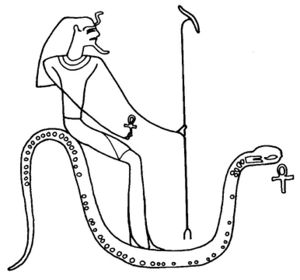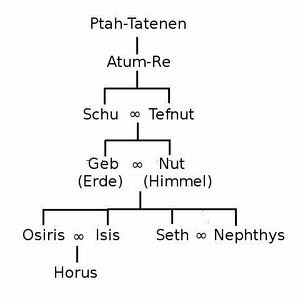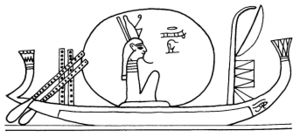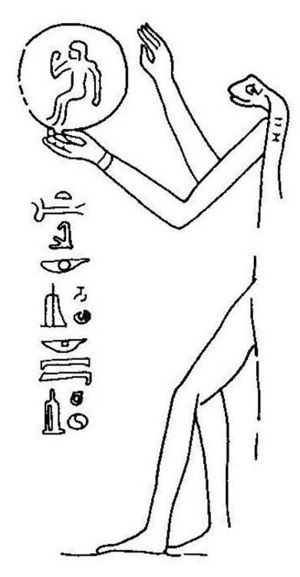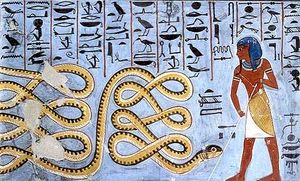آتوم
| Atum | ||||
|---|---|---|---|---|
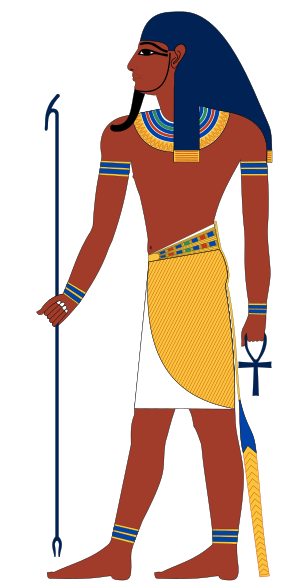 Atum is shown as a man with a was-scepter to show his power, and an Ankh to symbolize his association to life. He is only later and rarely shown with a Double Crown. | ||||
| الاسم بالهيروغليفية |
| |||
| مركز العبادة الرئيسي | عين شمس في المقاطعة الثالثة عشر | |||
| الرمز | التل الأزلي | |||
| معلومات شخصية | ||||
| القرين | إوسعاست[1] أو نبت حتپت[2] | |||
| الأنجال | شو وتفنوت | |||
آتوم ( Atum ؛ /ɑ.tum/, بالمصرية: jtm(w) أو tm(w)، أعيد بناء الاسم [jaˈtaːmuw]؛ بالقبطية ⲁⲧⲟⲩⲙ Atoum),[3][4] sometimes rendered as Atem أو Tem، هو الإله الأزلي في Egyptian mythology from whom all else arose. He created himself and is the father of Shu and Tefnut, the divine couple, who are the ancestors of the other Egyptian deities. Atum is also closely associated with the evening sun. As a primordial god and as the evening sun, Atum has chthonic and underworld connections.[5] Atum was relevant to the ancient Egyptians throughout most of Egypt's history. He is believed to have been present in ideology as early as predynastic times, becoming even more prevalent during the Old Kingdom and continuing to be worshiped through the Middle and New Kingdom, though he becomes overshadowed by Re around this time. وكان أعظم الآلهة المحلية التي كانت تعبد في الدلتا وتم توحيده مع الإله رع وسمي أتوم رع ملك الكون.
الاسم
Atum's name is thought to be derived from the verb tm which means 'to complete' or 'to finish'. Thus, he has been interpreted as being the "complete one" and also the finisher of the world, which he returns to watery chaos at the end of the creative cycle. As creator, he was seen as the progenitor of the world, the deities and universe having received his vital force or ka.[6]
الأصول
Atum is one of the most important and frequently mentioned deities from earliest times, as evidenced by his prominence in the Pyramid Texts, where he is portrayed as both a creator and father to the king throughout the collection of spells.[6] Several writings contradict how Atum was brought into existence. According to the Heliopolitan view, Atum originally existed in his egg within the primeval waters, being born during the primordial flood, becoming the source of everything that was created after him. The Memphites (priests of Memphis), on the other hand, believed that Ptah created Atum in a more intellectual way, using his speech and thought, as told on the Shabaka Stone.[7]
كان "آتوم" ملك الأرباب، والمظهر الأول لرب الشمس في "هليوبوليس" (عين شمس). ويعتبر "آتوم" من أقدم المعبودات المصرية، حيث كان يُنظر إليه على أنه الإله الأزلى الأكبر والأقدم، وذلك وفقـاً لنظرية "عيـن شمس" في خلق الكون.[8]
وقد ارتفعت مكانته وأهميته وفقاً لنظرية "عين شمس" في تفسير نشأة الكون، فقد نُسب إليه خلقُ أرباب (التاسوع) والكون، وأنه قد خلق الزوجَ الأول من الأرباب من "نفسه" عن طريق الاستمناء في يده، أو البصق والتفل.
نشأة الإله
إسم أتوم يعني الكامل أو التام ، وقد إعتقد المصريون القدماء أنه خلق نفسه من نفسه على قمة التل الأزلي ، ومن فهو خالق العالم ، وقد اندمج مع الإله رع وعرف باسم أتوم رع. ومقر عبادته كانت في عين شمس في المقاطعة الثالثة عشر.
"آتـوم" والتل الأزلى
يجسد "آتوم" التل الأزلى نفسه، والذى رج من المحيط الأزلى المسمى "نـون"، معلناً بدء الوجود والخليقة. وقد تمثل ذلك في حجر يسمى "بن بن"، والذى كان مقدساً في "عين شمس" منذ بداية العصور التاريخية، ثم تطور بعد ذلك إلى هيئة المسلات.
وقد ظهر "آتوم" فوق التل الأزلى في صورة المعبود "رع" بهيئة الطائر الأسطورى المسمى "بنـو"، وهو طائر العنقـاء (phoenix). وتشير النصوص المتأخرة إلى أن "آتوم" جسَّد التلَّ الأزلى نفسه.
تصويره
وقد كان "آتوم" يمثَّل في الهيئة الآدمية جالساً فوق عرشه، ويضع على رأسه التاج المزدوج. وأحياناً ما كان يصور في هيئة الثعبان استناداً إلى طبيعته الأزلية كرب خالق، أو قد يصوَّر في هيئة أسد، أو ثور، أو في هيئة "السحلية".
ولارتباطه بالشمس ورب الشمس، فإنه قد يصور أيضاً في صورة جعران. ولعل ذلك الجعران الضخم الممثل على البحيرة المقدسة بالكرنك كان قد كُرس له. وفى ضوء كونه الرب الأزلى والتل الأزلى، فقد يمثَّـل أحياناً في صورة التل الأزلى. كما أن "آتوم" ويده (التى قام بها بعملية الاستمناء، أو تفل فيها) قد صورا كزوج مقدس مع عصر الانتقال الأول .
أهميته
استمرت أهمية "آتوم" وعلاقته بالملك عبر العصور التاريخية القديمة، وذلك ما تؤكده نصوص إحدى البرديات المؤرخة بالعصر المتأخر، والمحفوظة حالياً بمتحف "بروكلين"؛ إذ تشير هذه البردية إلى أهمية الإله ودوره في عيد بداية العام، والذى يعاد التأكيد فيه على دور الملك.
وكان "آتوم" - الرب الخالق - مصدراً مطلقاً للقوة والسلطة الملكية التى نُقلت للمعبود "حـور" (حورس) الملك؛ وقد لُقب "آتوم" بلقب (أبو ملك مصر). ويشير الفصل (148) من "كتاب الموتى" إلى رغبة المتوفى في أن يكون بالقرب من "آتوم" حتى يكتسب منه قوته (وليجعله قوياً بالقرب من آتوم). وفى العصور المتأخرة كانت بعض التمائم بهيئة (السِّحلية) تُعلّق في دلاية حول الرقبة باعتبارها من رموز هذا المعبود.
دور المعبود "آتـوم" في خلق الكون
يعتبر المعبود "آتوم" هو الرب الخالق للكون والوجود وفقاً لمذهب "هليوبوليس" (عين شمس). وتؤكد النصوص على أنه قد خلق نفسه بنفسه، وأنه الأول والتام الذى أوجد نفسه من العدم. ويحمل اسم هذا المعبود فكرة (المجموع أو الكل). ومن الفقرات التى تحدثت عن الخلق:
قول كلامٍ: إنه "آتوم" الذى أتى إلى الوجود، المُستمنى في "هليوبوليس"، لقد وضع عضوه الذكرى في قبضته، واستمتع جنسياً به، فولد ... "شـو" و"تفنوت".
وقد لعب "آتـوم" دوراً بارزاً في جميع مذاهب الخلق، فيذكر مذهب "منف" أنه قد تم خلق المعبودات عن طريق فم "آتـوم". ومذهب "هرموبوليس" (الأشمونين) يشير إلى "آتوم" كخالق للثامون الأزلى. بينما رأى أصحاب مذهب "هليوبوليس" (عين شمس) أنه هو الرب الخالق الذى خلق الزوجَ الأول من الأرباب (شـو، تفنوت)، وذلك عن طريق الاستمناء.
Itm pw xprr msAw ir.f m Iwnw. Wdi n.f Hnn.f m xfa.f Ir.f nD mmt im.f ms sAty snty tw Hna tfnt
أنا الرب "آتوم" الذى أحدث الاستمناء باليد بنفسه في "عين شمس"، بأن وضع القضيب في يده، ليحدث نشوته عن طريق القذف. ثم ولادة الأخوين التوأمين "شو" و"تفنوت". فيد "آتـوم" هى التى تؤدى التصرف الجوهرى والحى للخلق، وهى المصدر الأساسى للقب (يد المعبود)، والذى اقترن بعد ذلك بكاهنات "طيبة"، واللاتى عُددن رمزياًَ كزوجات لآتوم. وتذكر النصوص حدوث عملية الاستمناء في المياه، حيث أرسل عينه لتبحث عن "شو" و"تفنوت" في المياه الأزلية. ومن المعروف أن عملية الاستمناء ترتبط بالمعبود "مين" (رب الخصوبة في مصر القديمة)، والذى يمثل في الهيئة الآدمية بقضيب منتصب. كما أن الخصوبة من صفات "آتوم" لكونه الرب خالق نفسه، وخالق الأرباب من نفسه.
الخلق عن طريق التفـل، أو العطس
إذ بعد أن قام "آتوم" بالاستمناء في يده، وضع منيَّه في فمه، ثم بصقه ليخلق المعبود "شـو"، وتَفَل فخُلقت الربة "تفنوت". وقد ارتبط "آتوم" بالعديد من المعبودات، مثل "روتـى" بهيئة الأسد، و"سـوبك" كرب أزلى.
Role
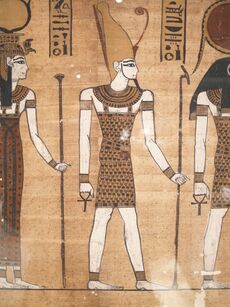
In the Heliopolitan creation myth, Atum was considered to be the first god, having created himself, sitting on a mound (benben) (or identified with the mound itself), and rose from the primordial waters (Nu).[9] Early myths state that Atum created the god Shu and goddess Tefnut by spitting them out of his mouth.[10][11] One text debates that Atum did not create Shu and Tefnut by spitting them out of his mouth by means of saliva and semen, but rather by Atum's lips.[12] Another writing describes Shu and Tefnut being birthed by Atum's hand. That same writing states that Atum's hand is the title of the god's wife based on her Heliopolitan beginning.[13] Other myths state Atum created by masturbation, with the hand he used in this act that may be interpreted as the female principle inherent within him[14] and identified with goddesses such as Hathor or Iusaaset. Yet other interpretations state that he has made union with his shadow.[15]
In the Old Kingdom, the Egyptians believed that Atum lifted the dead king's soul from his pyramid to the starry heavens.[11] He was also a solar deity, associated with the primary sun god Ra. Atum was linked specifically with the evening sun, while Ra or the closely linked god Khepri were connected with the sun at morning and midday.[16]
In the Coffin Texts, Atum has a vital conversation with Osiris in which he describes the end of the universe as a time in which everything will cease to exist with the exception of the elements of the primordial waters, stating that after millions of years he and Osiris would be the only ones to survive the end of time as serpents.[17] He claims that he will destroy everything he created in the beginning of existence and bring it back to Nu, the primeval waters,[18] thus describing the belief that the gods and goddesses would one day cease to exist outside of the primeval waters.[17]
In the Book of the Dead, which was still current in the Graeco-Roman period, the sun god Atum is said to have ascended from chaos-waters with the appearance of a snake, the animal renewing itself every morning.[19][20][21]
Atum is the god of pre-existence and post-existence. In the binary solar cycle, the serpentine Atum is contrasted with the scarab-headed god Khepri—the young sun god, whose name is derived from the Egyptian ḫpr "to come into existence". Khepri-Atum encompassed sunrise and sunset, thus reflecting the entire cycle of morning and evening.[22]
Relationship to other gods
Atum was a self-created deity, the first being to emerge from the darkness and endless watery abyss that existed before creation. A product of the energy and matter contained in this chaos, he created his children—the first deities, out of loneliness. He produced from his own sneeze, or in some accounts, semen, Shu, the god of air, and Tefnut, the goddess of moisture. The brother and sister, curious about the primeval waters that surrounded them, went to explore the waters and disappeared into the darkness. Unable to bear his loss, Atum sent a fiery messenger, the Eye of Ra, to find his children. The tears of joy he shed upon their return were the first human beings.[23]
Iconography
Atum is usually depicted in anthropomorphic form, wearing either the royal head-cloth or the dual white and red crown of Upper and Lower Egypt, reinforcing his connection with kingship. He is typically depicted sitting on a throne and will usually be represented with the head of a ram when he is mentioned within the context of his connection to the underworld and his solar attributes.[24] Sometimes he is also shown as a serpent, the form he returns to at the end of the creative cycle, and also occasionally as a mongoose, lion, bull, lizard, or ape.[6] When he is represented as a solar deity, he can also be depicted as a scarab and when in reference to his primeval origins he is also seen depicted as the primeval mound.[24]
Worship
Atum was worshipped throughout Egypt's history; the center of his worship centered on the city of Heliopolis (Egyptian: Annu or Iunu).[6] The only surviving remnant of Heliopolis is the Temple of Ra-Atum obelisk located in Al-Masalla of Al-Matariyyah, Cairo. It was erected by Senusret I of the Twelfth Dynasty, and still stands in its original position.[25] In the Old Kingdom Atum was at the center of the Egyptian belief system, being partly responsible for the origins of existence, having created himself and everything else out of the primordial waters. He is believed to have been present in ideology as early as predynastic times, becoming even more prevalent during the Old Kingdom as indicated by the pyramid texts in which he appears frequently. He continues to be found in the Middle Kingdom, during which he is depicted in the Book of the Dead in which he appears in spells to help with the journey to the Afterlife. Later, in the New Kingdom, there cults attributed to Atum, such as the Theban royal high priestesses known as the Divine Adoratrices of Amun who acted as the Hand of Atum in temple rituals at the time.[26] Re would take centerstage later on but as Atum was overshadowed, the people of ancient Egypt would continue to worship him through cultic rituals in which he is depicted as having close relationships with the king, as well as being represented through lizards on small reliquaries and amulets closer to the Late Period.[24]
انظر أيضا
- Animal mummy § Miscellaneous animals
- List of solar deities
- Solar myths
- قائمة الآلهة المصرية
- قدماء المصريين
المصادر
- ^ Wilkinson 2003, p. 150.
- ^ Wilkinson 2003, p. 156.
- ^ "Coptic Dictionary Online". corpling.uis.georgetown.edu (in الإنجليزية). Retrieved 2017-09-21.
- ^ "Thesaurus Linguae Aegyptiae". Berlin-Brandenburg Academy of Sciences and Humanities. Retrieved 2017-09-21.
- ^ Richard H. Wilkinson (2003). The complete gods and goddesses of ancient Egypt. Internet Archive. Thames & Hudson. pp. 98–101. ISBN 978-0-500-05120-7.
- ^ أ ب ت ث Wilkinson 2003, p. 99–101.
- ^ Wilkinson, Richard H. The complete gods and goddesses of ancient Egypt. New York: Thames & Hudson. pp. 17–18. ISBN 0-500-05120-8. OCLC 51668000.
- ^ آتوم
- ^ The British Museum. "Picture List" (PDF). Archived (PDF) from the original on 2013-09-22. Retrieved 2012-04-04.
- ^ Watterson, Barbara (2003). Gods of ancient Egypt. Stroud: Sutton. ISBN 0-7509-3262-7. OCLC 53242963.
- ^ أ ب "The Egyptian Gods: Atum". Archived from the original on 2002-08-17. Retrieved 2006-12-30.
- ^ Lloyd 2012, p. 409.
- ^ Lloyd 2012, p. 150.
- ^ Wilkinson 2003, p. 17-18, 99.
- ^ "The Egyptian Creation Myth — How the World Was Born". Experience Ancient Egypt. Archived from the original on 2010-01-09.
- ^ Wilkinson 2003, p. 205.
- ^ أ ب Wilkinson, Richard H. The complete gods and goddesses of ancient Egypt. Thames & Hudson. pp. 20–21. ISBN 0-500-05120-8. OCLC 51668000.
- ^ Wyatt, Nicolas (2001). Space and Time in the Religious Life of the Near East. Bloomsbury Publishing. ISBN 978-0-567-04942-1. OCLC 893336455.
- ^ Toorn, Becking & Horst 1999, p. 121.
- ^ Ellis, Normandi (1995-01-01). Dreams of Isis: A Woman's Spiritual Sojourn (in الإنجليزية). Quest Books. p. 128. ISBN 9780835607124.
- ^ Bernal, Martin (1987). Black Athena: The linguistic evidence (in الإنجليزية). Rutgers University Press. p. 468. ISBN 9780813536552.
- ^ Toorn, Becking & Horst 1999, p. 123.
- ^ Pinch, Geraldine (2004). Egyptian Mythology: A Guide to the Gods, Goddesses, and Traditions of Ancient Egypt. Oxford University Press. pp. 63–64
- ^ أ ب ت Wilkinson, Richard H. The Complete Gods and Goddesses of Ancient Egypt. New York: Thames & Hudson. pp. 100–101. ISBN 0-500-05120-8. OCLC 51668000.
- ^ Butler, John Anthony (2019-01-22). John Greaves, Pyramidographia and Other Writings, with Birch's Life of John Greaves (in الإنجليزية). Cambridge Scholars Publishing. p. 154. ISBN 978-1-5275-2668-6.
- ^ Pinch, Geraldine (2011). Handbook of Egyptian mythology. ABC-CLIO. pp. 31–32. ISBN 978-1-84972-853-9. OCLC 730934370.
سليم حسن (1992). موسوعة مصر القديمة. الهيئة العامة للكتاب.

